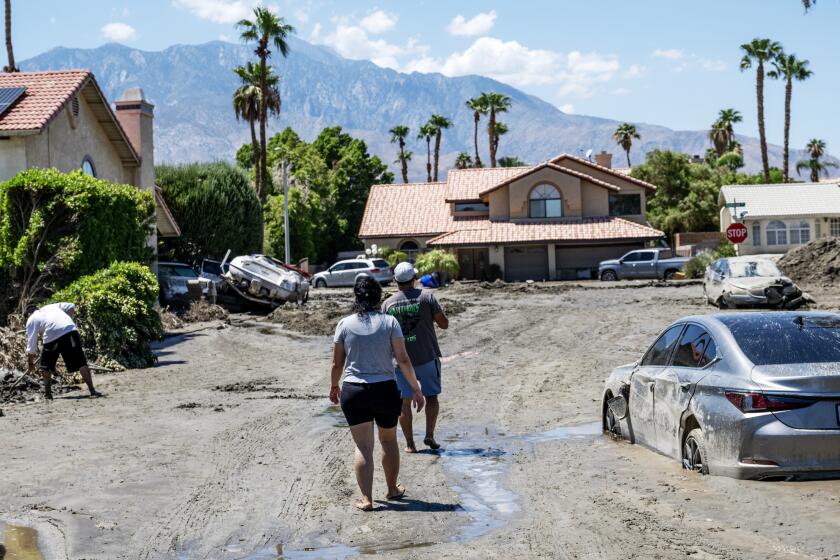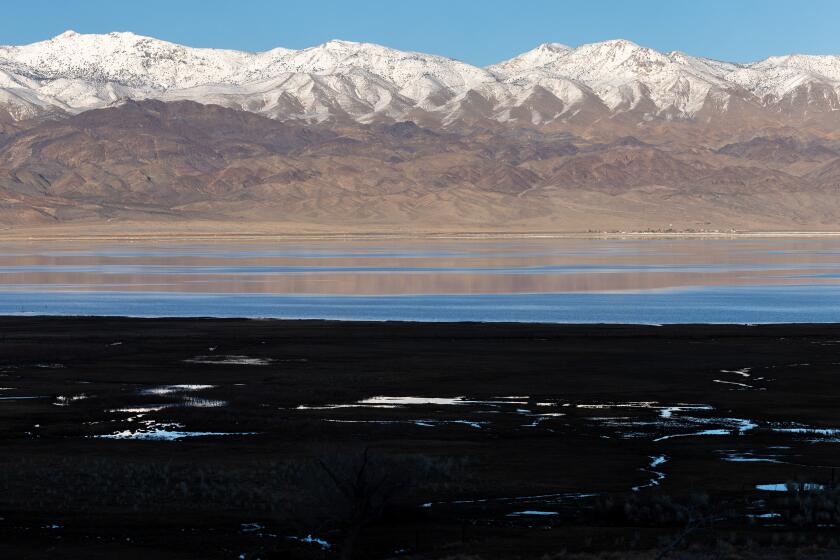The latest unfounded conspiracy theory: Cloud seeding is to blame for California’s storms and flooding

- Share via
When a water agency for most of California’s Inland Empire and parts of Orange County started a pilot program to seed clouds in the region in November to see if it could increase water supplies, officials expected to face some questions and skepticism.
What officials didn’t expect was to be wrongly accused by conspiracy theorists and critics of causing one of California’s strongest storms in recent history — or, worse yet, trying to poison the region.
Shortly after Southern California was hit by two major storms in February, dropping more than a foot of rain in some areas and causing floods and landslides, conspiracy-peddling accounts on social media have tried to blame the strength of the storms on the Santa Ana Watershed Project Authority (SAWPA), a joint-power agency tasked with overseeing and protecting the Santa Ana River Basin that includes San Bernardino, Riverside and Orange Counties.
In videos and social media posts, the accounts suggest — without evidence — that the agency’s new cloud-seeding program caused the two February storms. Shared thousands of times, the posts have prompted people to leave expletive-filled comments on the agency’s social media accounts. Others have reached out directly to employees at the agency, accusing them of damaging people’s homes by causing the storm or trying to poison communities with cloud-seeding chemicals.
Despite the accusations, agency officials said there was no cloud seeding during the last two major storms and, more important, cloud seeding can’t create storms themselves. The agency also pointed to multiple studies that have been published over several decades, showing that the level of silver iodide used in cloud seeding is not toxic to humans and 1,000 times lower than the Environmental Protection Agency’s drinking water standards.
The program, said Jeff Mosher, general manager of the Santa Ana Watershed Project Authority, is just one of the ways that officials are looking to boost water supplies to the watershed’s dams and basins, which serve about 6 million residents across four counties.
Hilary prompted the first-ever tropical storm watches and warnings in California, but officials now say it had degenerated into a post-tropical low when it hit.
In San Diego County, where some have blamed the agency for the storm’s damage, officials have had to point out that cloud seeding hasn’t taken place in the county.
But that hasn’t stopped emails and calls to the agency, or comments left on its social media accounts.
“Thanks to dumb [expletive] like you there’s mudslides and flooding in California,” one person told Mosher on the social platform X.
“Any other depopulation projects in the works?” another person asked on Instagram.
When the agency launched the program in November, Mosher said, he expected it to get some scrutiny. Although cloud seeding has been around for decades, many people are unfamiliar with the practice. But shortly after the storms, he said, he and others at the agency have seen a significant increase in emails and calls repeating some of the conspiracy theories being spread on social media.
In recent days, for example, he and others have fielded multiple emails and calls accusing SAWPA of causing the flooding in the wake of the storms. Other calls accuse the agency of causing chemtrails — a conspiracy theory claiming that condensation trials left behind by airplanes are toxic chemicals being sprayed on people for some unspecified nefarious reason.
Chemtrails have been associated with the practice of cloud seeding and seem to have been incorrectly associated with SAWPA’s program as well, even though the agency does not use planes and instead seeds clouds from ground units.
Mosher has pointed out to some people that the agency did not cloud-seed during the Feb. 3-8 or Feb. 18-19 storms because meteorologists were predicting significant, even catastrophic, rain.
According to the agency, the last time it seeded clouds near the watershed was Feb. 1. And officials point out that, according to their own estimates, cloud seeding can increase precipitation by only about 5% to 10%.
But the emails and comments have continued, especially after one of the online videos pushing the conspiracy theory encouraged people to reach out directly to Mosher and two other employees at the agency.
A Super Bowl tweet by President Biden appeared to poke fun at those who believe that he, Taylor Swift and the NFL conspired for a Chiefs win over the 49ers in Vegas.
The video, which has received thousands of likes on Instagram but was flagged Thursday for spreading false information, starts ominously with images of the damage caused by the storms.
“If the disastrous flooding and record rainfall hitting Southern California right now doesn’t seem natural to you, it’s probably because it isn’t,” a woman says, narrating a video of flooding and water rescues.
“We now have information from the government itself that it is performing weather modification, aka, cloud seeding,” a man follows up.
The video claims that the Santa Ana Watershed Project Authority “boasts about blasting cancer-linked silver iodide mixed with acetone.”
The problem with the claims is that cloud seeding has not been a clandestine practice as the video claims, but has been discussed and studied in the open. Those studies, conducted over decades, have also found that the level of silver iodide used in seeding is so small it has had no noticeable effect on the environment, wildlife or the air breathed by people nearby.
The acetone, which is used when releasing silver iodide particles from the ground, converts into water and carbon dioxide, a spokesperson for the agency said.
Yet the conspiracy has seemed to piggyback off of other unfounded theories, such as chemtrails.
Some of the accounts pushing the conspiracy theory on TikTok and Instagram have tens of thousands of followers and have peddled other conspiracy theories, such as claims that the Jan. 6 attack on the U.S. Capitol was orchestrated by the FBI, that world governments are in fact run by a secret cabal known as the New World Order, and that popular singer Taylor Swift is a psychological operation orchestrated by the Pentagon.
But like other misinformation that has infected social media platforms, the conspiracy has spread into the real world. In San Diego, one resident blamed the county Board of Supervisors for the flooding and damage caused by the recent storms.
“You guys seeded us on purpose,” the resident said during the board’s Feb. 6 meeting. “You destroyed these people’s homes. They didn’t have flood insurance, but you all knew that.”
The resident, identified as “Kiera,” wore a black hat that read, “COVID’s a scam.” Video of her comments has been shared on social media, pushing the unfounded claim that water seeding was to blame for the storms.
For 22 years, the Conscious Life Expo has been a meetinghouse for astrologers, channelers, aura readers, quantum life coaches, psychics, hypnotists and “starseeds” — people who believe they are galactic volunteers that have taken on a human form to help “the children of Gaia.”
To back up her claim, the resident cited the Santa Ana Watershed Project Authority’s cloud-seeding program, even though the agency does not operate in San Diego County and the program is not being conducted there.
The resident also alluded to chemtrails.
“You don’t think that anything is going on in the skies that you see?” she said. “We’ve seen those for years.”
Timothy Tangherlini, a professor at UC Berkeley who has studied conspiracy theories, said it’s common for them to be tied to other debunked theories in order for them to spread.
“They link them together in these super-conspiracy theories that are totalizing, and they give you an understanding of the world, a real us-versus-them thing,” he said. “That’s how conspiracy theories are held together.”
Older conspiracy theories often help new conspiracies take root, offering people who are being exposed to the information some familiarity.
“Now next time you see it again, you see it from a couple of different sources, you think there may be something to that,” Tangherlini said.
Conspiracy theories and misinformation have been particularly prevalent in the last couple of years, fueled by political polarization and distrust of government, official, scientific and journalistic sources, he said.
“Conspiracy theories are not really robust and you can make them fall apart, but they’re incredibly resilient,” he said. “That’s why you see them come back to life.”
In this case, he said, the storms that dumped more than a foot of rain in some parts of Southern California were more likely the result of climate change. For some of those who don’t believe in climate change, or are politically opposed to action to address it, a conspiracy theory trying to lay blame on the storm to an unlikely, unseen, unproven force may seem more palatable than coming to terms to the visible effects of it.
“In some ways it’s a counter-argument,” Tangherlini said. “People are saying this is due to climate change, and they’re like, ‘No, no, no, because in my ideological background I’m not a fan of climate change.’”
Storms in February have significantly boosted California’s snowpack, giving the state near-average conditions and ample water supplies.
Mosher, who has watched some of the conspiracy videos, said he tries to see the misinformation as an opportunity, especially if it steers some people to the agency’s website to learn more about the program.
“We’re a public agency and we look for comments from the public, questions from the public, so we can respond to them,” he said. “If people see those posts and contact us through email for our weather modification program and they have questions, we’ll respond.”
The agency, after all, is trying to be transparent about the program, he said.
“Our goal isn’t to change people’s minds — their opinions are their opinions,” he said. “We just want to give them the information to help.”
More to Read
Sign up for Essential California
The most important California stories and recommendations in your inbox every morning.
You may occasionally receive promotional content from the Los Angeles Times.


















